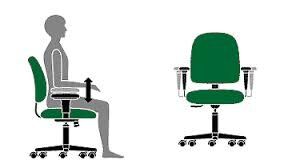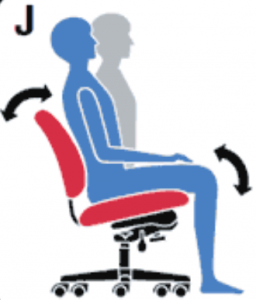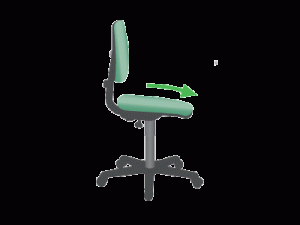Office Chair Ergonomic Adjustments. Do you know what adjustments are available on office chairs?
This article details the main office chair ergonomic adjustments. Also factors to consider when choosing new office seating.
It is ideal to have as fully adjustable seating as possible. This will suit as many of the

individual needs as possible.
1. Seat Slide
Seat slide is a good option to have for different upper leg thigh lengths and bottom sizes.
Some chairs allow up to 10cm depth adjustment.

2. Height adjustable arm rests
Height adjustable arm rests are beneficial, as long as the arm rests are not too far forwards. This is useful if the user is of larger build. If a petitie build the arm rests can interfere with sitting close to the desk. Especially if it is a curved front desk.

Having a range of chair models with different seat pad widths can help suit different users builds. If the arm rest pads tilt inwards at the front, over the seat pad, this can overcome seat pad width issues for smaller build users. Very petite build individuals may still not be accommodated. Arm rests with adjustable brackets move the arm posts closer of further from the seat pad suit different builds, including larger builds.
3. Movement mechanism
The movement mechanism in the chair allows some variety of posture during use. This prevents static posture. It could be one of the following:
Synchro mechanism tilts the back rest and seat pad backwards (up at the front), together often on a ratio of 2:1.

Often contract standard office seating has this mechanism. This may be problematic to those with low back pain, where more openness in the hip angle to the back angle is preferred. Also due to the knee being above the hip when reclining.
Therefore an Asynchro or Independent mechanism can be preferable. The seat pad can stay level/horizontal or move seperately. Or with a forward seat tilt lever (knee lower than hip) and a back rest lever to recline the back rest, which operate independently. This can help individual’s with low back pain and other discomfort, such as hip pain.
Knee below hip:

The mechanism considered to be ‘better’ on the market, is a ‘free float’, sometimes a knee tilt mechanism where open angles can be achieved with the seat and the back rest to be altered in angle but still being in some form of connectivity, to also allow independent movement and ‘free float’ or rocking together during use. Extra levers on the chair often allow these extra movements. This can help individuals with low back pain and hip pain.
Chair manufacturers describe the movement mechanisms using a variety of terms and so the detail above is what I have gleaned from working in this field, therefore more detail of individual model and seating ranges and their available mechanisms should be obtained from the manufacturer of any chairs you choose to consider, bearing in mind the principles detailed above.
4. Tensioner
On all chairs it is beneficial to have a tension wheel (+ and -) to adjust the movement resistance to make the movement more comfortable, (not too loose to gain no support from the back rest during its movement and not too stiff to cause the back to have to ‘work’ to gain any back rest movement). Chairs which do not have a tension wheel are not generally designed to have the chair left in an unlocked mode during use, rather to adjust the angle and re-lock, but this can contribute to static postures and discomfort, as movement during chair use is generally considered beneficial for most individuals.
back rest movement). Chairs which do not have a tension wheel are not generally designed to have the chair left in an unlocked mode during use, rather to adjust the angle and re-lock, but this can contribute to static postures and discomfort, as movement during chair use is generally considered beneficial for most individuals.
5. Lumber Support
The lumbar support range is designed to suit a range of lumbar heights (with back rest height adjustment usually), but sometimes this may not be suitable if an individual requires a very high lumbar (30cm) or prefers very low support (15cm) which sometimes is more pelvic area support preferred than the traditional lumbar support. They would require an alternative chair model in most cases, unless a supplier is able to offer a range of lumbar heights on different chairs in the range. Adjustable lumbar depth pump (air filled pump option or other methods) is good to have on chairs so that individuals can vary the amount of lumbar support.
may not be suitable if an individual requires a very high lumbar (30cm) or prefers very low support (15cm) which sometimes is more pelvic area support preferred than the traditional lumbar support. They would require an alternative chair model in most cases, unless a supplier is able to offer a range of lumbar heights on different chairs in the range. Adjustable lumbar depth pump (air filled pump option or other methods) is good to have on chairs so that individuals can vary the amount of lumbar support.
6. Gas Stem range
The gas stem range is also important to allow individual to raise the chair sufficiently to the fixed desk height, so that their elbows are horizontal with the keys. Often a gas stem up to 55 or 57cm high sitting height is required, however, some suppliers can accommodate higher ranges and the chair movement still be fully adjustable.
7. Castor type

Wheel castors to suit the flooring also need to be specified. Hard castors for a carpet, and soft castors for a hard floor, to stop it from rolling away and being dangerour to get on/off safely. ‘Glide and lock’ or ‘Glides’ on chairs are often problematic, as once seated on the chair it cannot be moved closer to the work surface.
There are other seating options which may be required for more specialist individual circumstances, which would need to be assessed in more detail.
We hope this information about office chair ergonomic adjustments is useful. You may need a Workstation Assessment for further professional advice about your set up. This can prevent issues in the future or resolve issues you are currently experiencing.
See our services related to this topic:
A prevention assessment for no symptoms or minor/occasional symptoms, see DSE Workstation Risk Assessment. to fulfil the HSE DSE Regulations 1992
If you have ongoing health needs, you may need a more in depth review, see Ergonomic Workstation Assessment. to also advise on reasonable adjustments under the Equality Act 2010.
See our Case Studies:
Ergonomic Assessment in an Office Role Case Study
Ergonomic Assessment of a Teacher Case Study
Ergonomic Assessment & Return-to-Work Case Study
See our blog articles related to this topic:
- What is a Workstation Assessment?
- Occupational Health Assessments at work
- Mobile & Homeworking DSE Assessment
- Pain using an office chair
Contact Us for further advice. Tell us your circumstances and we can advise what assessment will be needed.
DISCLAIMER: THIS WEBSITE DOES NOT PROVIDE MEDICAL ADVICE
The information, including but not limited to, text, graphics, images and other material contained on this website are for informational purposes only and is not to be used or relied on for any diagnostic or treatment purposes. The purpose of this website is to promote broad consumer understanding and knowledge of various health topics. This information is not intended to be patient education, does not create any patient-physician relationship, and it is not intended to be a substitute for professional medical advice, diagnosis or treatment. Always seek the advice of your physician or other qualified health care provider with any questions you may have regarding a medical condition or treatment and before undertaking a new health care regime, and never disregard professional medical advice or delay in seeking it because of something you have read on this website.
Healthywork Ltd does not recommend or endorse any specific tests, physicians, products, procedures, opinions or other information that may be mentioned on this website. Reliance on any information appearing on this website is solely at your own risk.





